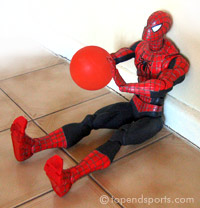This test is also called the medicine ball chest pass, and there is a similar test using a powerball: the Powerball Chest Launch (kneeling). The following information describes the procedures as once used for the NHL pre-draft testing combine (though the test is no longer used). The "Seated Power Throw" test, part of the US Army Occupational Physical Assessment Test, is very similar that described below, though using a 4.4 pound (2 kg) medicine ball.
purpose: This test measures upper body (arm) strength and explosive power. By keeping the back in contact with the wall the strength of the arms only are tested.
equipment required: 4 kg (~ 8 lb) medicine ball, wall, tape measure.
pre-test: Explain the test procedures to the subject. Perform screening of health risks and obtain informed consent. Prepare forms and record basic information such as age, height, body weight, gender and test conditions. Check and record the weight of the ball. Perform a standard warm-up, with practice aiming for the ideal release angle. See more details of pre-test procedures.
procedure: The athlete sits on the floor with his legs fully extended, feet 24 inches (~60 cm) apart and with the back against a wall. The ball is held with the hands on the side and slightly behind the center and back against the center of the chest. The forearms are positioned parallel to the ground. The athlete throws the medicine ball vigorously as far straight forward as he can while maintaining the back against the wall. The distance thrown is recorded.
scoring: The distance from the wall to where the ball lands is recorded. The measurement is recorded to the nearest centimeter (other protocols have used the nearest 0.5 foot or 10 cm). The best result of three throws is used.
variations: 1-2 kg medicine balls are sometimes used too, depending on the abilities of the participants being testing. The weight of the medicine ball will obviously affect results, and should be selected to best test the age group or abilities of your participants. There is also a similar test using a basketball. The Powerball Chest Launch similarly tests upper body power, however as the subject is kneeling they can utilize the torso to project the ball further. The sitting test can also be performed without a wall, so that the torso can also be used to help propel the ball. See also other medicine ball throw tests.
target population: This protocol is as used for the NHL, though this test would be suitable for any sports in which upper body strength is important, for example rowing and tennis.
advantages: this test is easy and quick to perform for an individual.
disadvantages: several people are needed to conduct this test smoothly: one to mark results, another to check technique and another to collect and return the balls. If testing a large group, it can be time consuming to put all the participants through this test.
comments: The angle the ball is thrown is important. You may want to explain to the subject about the optimal angle for maximal distance, and to allow some practice attempts. You may aid in the ease of measurement for this test by extending a tape measure out along the expected path in front of the subject. When recording the distance, you can either move the tape to where the ball landed, or less accurately align where the ball landed to the approximate distance on the tape.
The Test in Action
- This test was once used for the NHL pre-draft testing combine
- The US Army Occupational Physical Assessment Test has a very similar "Seated Power Throw" test.
- The UK Army uses this test for new recruits.
Similar Tests
- Powerball Chest Launch
- Basketball Throw — two-handed push power with the back against a wall.
- Bench Press Max Power
- Kneeling basketball throw test — a one-handed throw for distance from the kneeling position.
Related Pages
- More Medicine Ball Fitness Tests
- The "Seated Power Throw" test, part of the US Army Occupational Physical Assessment Test, is very similar that described above, though using a 4.4 pound (2 kg) medicine ball.
- More about the NHL pre-draft testing combine.
- About the US Army Occupational Physical Assessment Test
- Other speed and power tests
- About Medicine Balls
- Medicine balls for sale
- Why Spider-Man?


 Current Events
Current Events